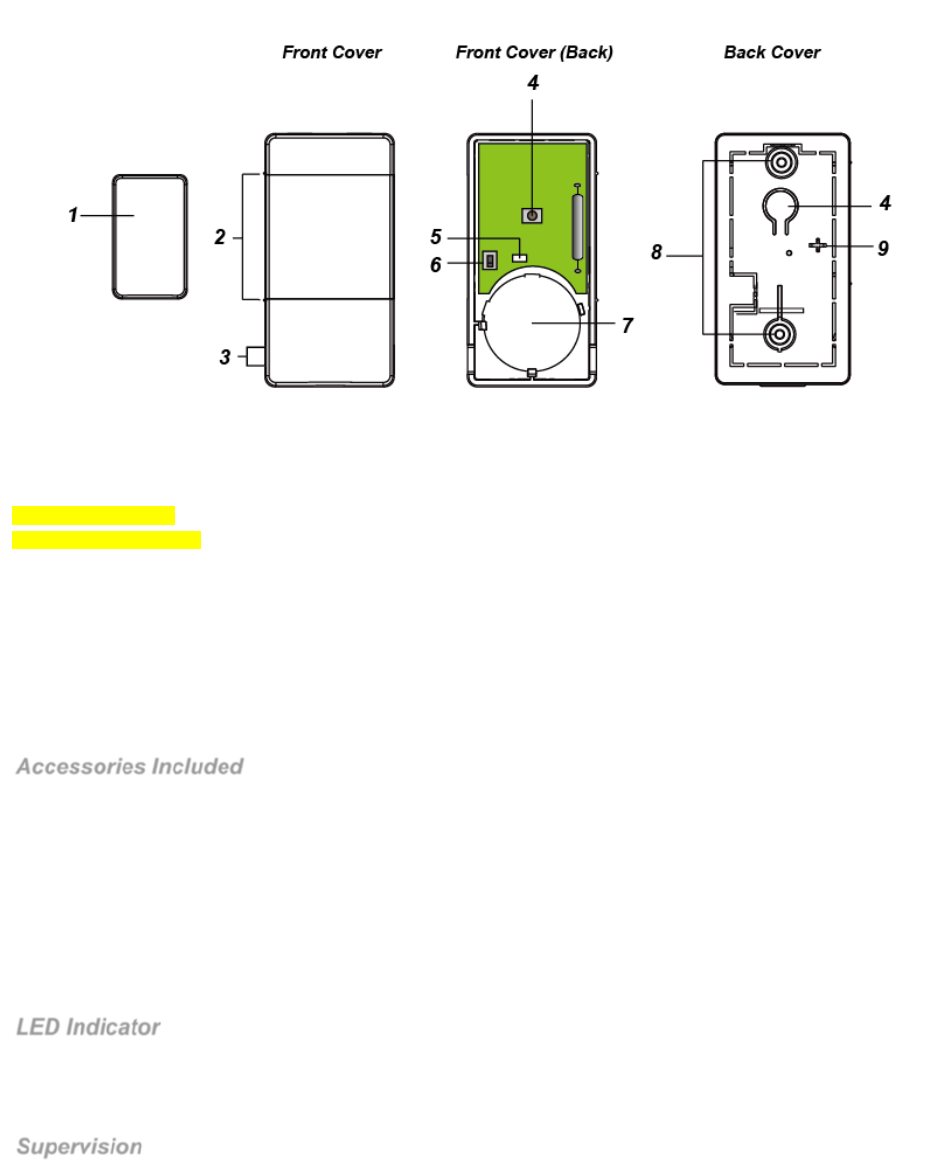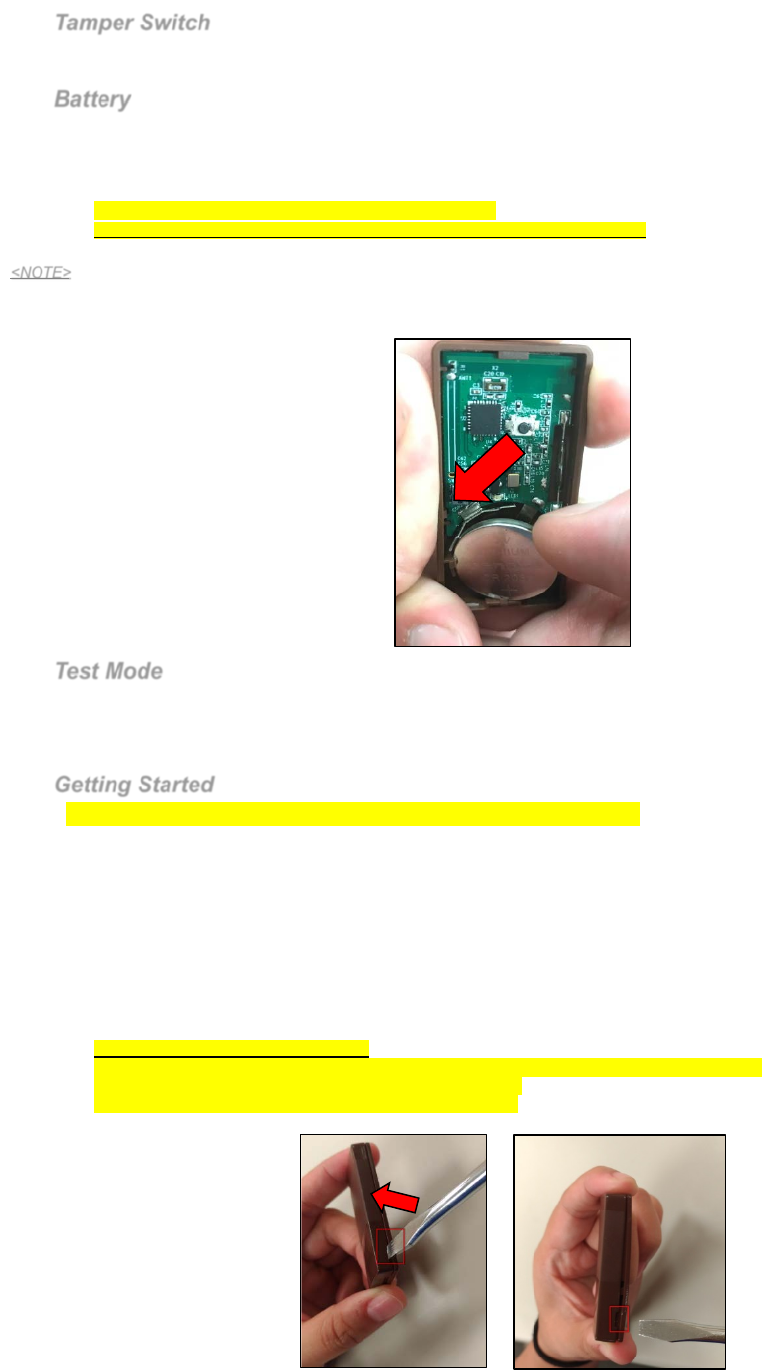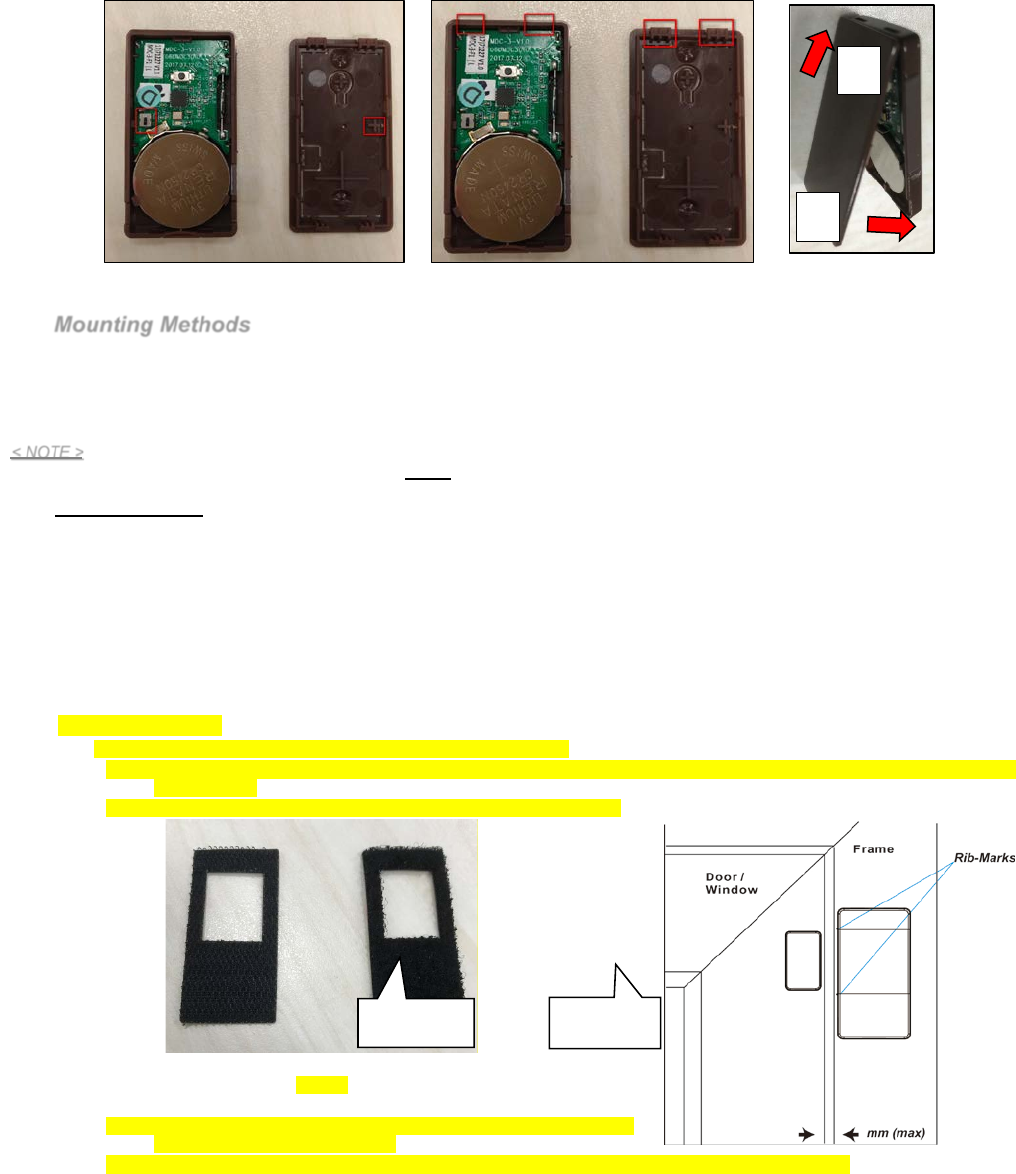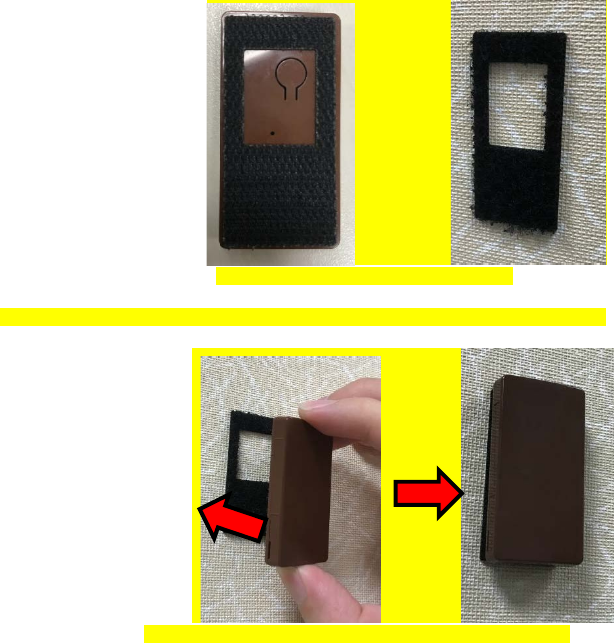Climax Technology Co MDC3 Mini Door Contact User Manual Door contact
Climax Technology Co Ltd Mini Door Contact Door contact
Users Manual

Mini Door Contact (MDC-3) User Manual
The Mini Door Contact monitors the opening/closing of specified devices (e.g. door or window). The Door Contact is fixed to the monitored
device frame with an actuating magnet fixed to the device. When the door or window opens, the magnet moves away from the Door Contact,
activating an internal magnetic switch causing the Door Contact to transmit alarm signal to the Control Panel. The device also has the
capabilities of communicating signal problems along with low battery situations.
The Door Contact design is consisted of a front cover and a back cover. The front cover(back) contains all electronics and the back cover
provides a means for fixing the device. An enclosed PCB tamper switch provides tamper protection against unauthorized device opening.
Identifying the parts
1. Magnet
- Mount the magnet on the side of the Door Contact where it has 2 rib-marks to indicate the position of the internal magnet switch.
The Door Contact should be installed either upright or inverted to ensure that the rib-marked side faces the magnet.
2. Rib Marks
3. Battery Insulator
4. Learn / Test Button
- Press the Test button to transmit a learn code.
- Press the Test button once to enter Test Mode for 3 minutes.
5. Red LED Indicator
6. Tamper Switch
7. Battery
8. Mounting Holes (Knockouts)
9. Tamper Compression Mark
Accessories Included
a) 1 Magnet
b) 2 Screws
c) 4 Wall Plugs
d) 1 double-sided adhesive tape pad
e) 1 Magnet double-sided adhesive tape pad
f) 2 Magnet mounting screws
Features
LED Indicator
In Normal operation mode, the LED indicator remains off except in the following situations when:
When Door Contact’s Tamper switch is triggered.
When the Door Contact is activated with either Tamper or Low battery condition.
When the Door Contact is activated and transmitting the signal under the Test mode.
Supervision
The Door Contact will automatically transmit Supervisory signals periodically to the Control Panel at random intervals of 30 to 50
minutes in Normal Operation Mode.
If the Control Panel has not received the signal from the Door Contact for a preset period time, the Control Panel will indicate
1

that particular Door Contact is experiencing an out-of-signal problem.
Tamper Switch
It is designed to protect against unauthorized, cover opening. When the tamper is triggered, Door Contact will emit a signal to
the Control Panel for reporting, the LED will also light up.
Battery
The MDC-3 uses one 3V CR2450 Lithium battery as its power source
The Door Contact is also capable of detecting low battery. When the battery is low, a low battery signal will be sent to the Control Panel
along with regular transmission. The LED will light up when the Door Contact is activated under low battery status.
Changing Battery
You need to open the cover to insert/remove the battery
(Please refer to Installation on how to remove the Door Contact’s cover for details)
After the battery has been removed, press the Learn / Test button 5-6 times to fully discharge before inserting the new battery.
<NOTE>
Make sure the battery mark with the positive side (+) is faced upwards when inserting the battery.
Make sure to insert or place the battery from the top right angle in the Front Cover (Back) view:
Test Mode
The Door Contact can be put into Test mode for 3 minutes by pressing the Test Button on the front cover (back) once. During Test mode,
the LED indicator will turn on upon triggering. Each press on the Test Button, the Door Contact will transmit a test signal to the Control
Panel for radio range test and resets the test mode back to the 3-minute duration. It will exit Test Mode automatically after the 3 minutes
and returns to Normal Operation mode.
Getting Started
Step 1: Remove the battery insulator located at the rear side of the Door Contact.
Step 2: Put the Control Panel into learning mode, refer to Control Panel manual for detail.
Step 3: Press the Learn/Test Button on Door Contact to send signal to the Control Panel.
Step 4: If the Control Panel successfully receives the signal, the Control Panel should respond (e.g. emitting beeps). Refer to your
Control Panel manual to complete the learning process.
Step 5: After the Door Contact is learnt-in, put the Control Panel into “Walk Test” mode, hold the Door Contact at the desired location,
and press the Test button to confirm if this location is within signal range of the Control Panel.
Step 6: When you are satisfied with the Door Contact at the chosen location, proceed to installation.
Installation
To open the cover of the Door Contact:
Step 1. Use a flat-headed screwdriver to fit into the cover opening hole on one side as (Pic1).
Step 2. Push the flat-headed screwdriver upwards as (Pic2).
Step 3. Turn to the other side and repeat Step 1 and Step 2.
(Pic 1)
(Pic 2)
Step 4. Once opened the cover, you can proceed to change the battery etc.
Step 5. To replace the cover:
2

- Make sure the Tamper Compression Mark is aimed at the Tamper Switch (Pic 3).
- Also make sure the bottom hooks of the back cover is latched on the bottom of the front cover (back) as (Pic 4)
- Fit the bottom hooks into the bottom latches of the front cover (back) then push it downwards as (1) in (Pic 5), then push
forward (2) the entire back cover to close it until you hear a clip sound.
(Pic 3)
(Pic 4)
(Pic 5)
Mounting Methods
Mount the Door Contact using one of the below mounting methods: Self-adhesive Mounting and Screw Mounting.
Mount the magnet on the more mobile object (such as door) using either the smaller double-sided adhesive pad or the screws
provided.
Align the magnet according the rib mark on Door Contact.
< NOTE >
The magnet should be no more than 15mm from the detector when the door is closed.
Mounting Methods:
Screw Mounting
The back cover has two Mounting Holes (knockouts), where the plastic is thinner, for mounting purpose.
To mount the Door Contact:
I. Remove the cover (See Installation above).
II. Break through the knockout on the back cover.
III. Using the holes as a template, drill both holes.
IV. Insert wall plugs if fixing into plaster or brick.
V. Screw the back cover into the wall plug using a Philips screwdriver.
VI. Attach the front cover to the back cover (see Pic 3 ~ 5 above).
Wall Mounting:
The Door Contact can be wall mounted using Velcro tape provided.
I. Clean the wall mounting location and back of the Door Contact with degreaser. Do not mount on wall with cracking paint or
rough surface.
II. The Velcro tape can be separated to Hook and Loop side (Pic 6.).
(Pic 6.)
III. Remove the protective cover of the Hook side and attach to the
back of the Door Contact (Pic 7.)
IV. Remove the protective cover of the Loop side and apply to desired mounting location as in (Pic 8.)
1
2
Hooks
Loops
3

(Pic 7.) (Pic 8.)
V. Apply the Door Contact on the Loop side Velcro taped on the wall (Pic 9 & 10.)
(Pic 9.) (Pic 10.)
This device complies with Part 15 of the FCC Rules. Operation is subject to the following two conditions:
(1) This device may not cause harmful interference, and
(2) This device must accept any interference received, including interference that may cause undesired
operation.
4